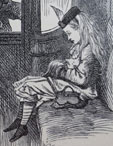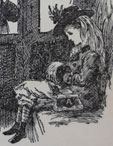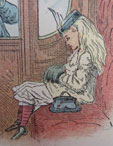Project Summary
It is almost 150 years since the first publication of Lewis Carroll's Alice's Adventures in Wonderland in 1865. Yet what has recently been referred to by Michael Volpe as the 'allure' of Alice goes on unabated in diverse spheres across the world. The books in which she appears continue to be widely read, studied, researched and adapted to an eclectic range of media. In addition, a vast array of people – young and old, world-famous and unknown – design clothes for her, wear clothes which she adorns and dress like her.
From wallpaper to biscuits tins
As such, she constitutes an ideal case for an examination of the interconnections between fashion and fiction. This project explores the many different ways in which Alice was dressed in the books themselves and in the wide array of related articles, from wallpaper to biscuits tins, produced in Carroll's lifetime.
It also traces the adoption of Alice as a character to be embodied by real children in the context of dramatic adaptations of the stories (professional and amateur) and also in the hugely popular fancy dress balls and parties of the period. Alice is thus placed within both a literary and artistic context, in relation to writers, illustrators, performers and playwrights, but also in the everyday experiences and activities of ordinary children, providing insight into the ripple effect of literary works in the lives of young readers.
The iconicity of Alice
Through its innovative dress-based approach, the project aims to contribute to ongoing critical debates about Alice's character and to contextualise, historicise and thereby defamiliarise a character whose visual identity is now so firmly fixed. It traces the evolution of her visual identity in unprecedented detail, pinpointing the emergence of specific features, such as her association with the colour blue, and of her iconicity more generally.
Drawing attention to her multiplicity from the first, it challenges received critical ideas which have placed the proliferation of her visual identity only in the early twentieth century. By focusing on dress not only in illustration, material culture and professional adaptation, but also in amateur productions and fancy dress, the project will extend study of the reception, transmission and evolution of the Alice books into the wider world – both beyond the UK, and beyond the textual.
Cultural contexts
A more detailed understanding of Alice in the nineteenth century provides the foundations for studies moving into later periods and their associated media, and examining alternative cultural contexts. But the project also aims to open up possible avenues and approaches for academics other than Carroll specialists, bringing dress within the purview of children's literature researchers and the realm of childhood within that of fashion(/fiction) scholars.
Crucially, in addition, the project’s methodology which focuses on dress and combines a diverse range of source materials, especially relating to the distinctly understudied form of fancy dress, will be eminently transferable and can be used to chart the afterlife of any character across time and space.
In association with:






